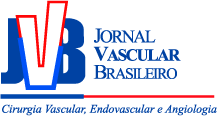Tradução, adaptação cultural e validação do questionário de avaliação sintomática do lipedema (QuASiL)
Translation, cultural adaptation, and validation of a lipedema symptoms questionnaire
Alexandre Campos Moraes Amato; Fernando Campos Moraes Amato; Daniel Augusto Benitti; Ricardo Virgínio dos Santos
Resumo
Palavras-chave
Abstract
Background: Lipedema is characterized as abnormal bilateral deposition of fat in the buttocks and legs that may be accompanied by orthostatic edema in women. A questionnaire for assessment of lipedema symptoms has previously been published in German and English to assess treatment progress. Objectives: To translate, culturally adapt, and validate the lipedema symptoms assessment questionnaire for Brazilian Portuguese. Methods: The process involved three translations and two back-translations performed by independent translators, followed by construction of a consensus version and adaptation according patients’ comprehension. The questionnaire was converted into a digital version and administered to 56 volunteers and then administered to 154 patients from a vascular clinic and correlated with volume determined by segmental bioimpedance. Results: The 20 pre-test patients were female and at least 90% of the interviewees were able to understand the questions in the final phase. Volunteers had a 96.4% rate of comprehension of the digital online version and a mean completion time of 4 minutes. In 154 patients, limb volume was positively correlated with intensity of symptoms, as assessed by the translated questionnaire, and 3 out of 15 questions were weakly correlated with educational level. Conclusions: The translated and culturally adapted Brazilian Portuguese version of the lipedema symptoms assessment questionnaire (QuASiL) is a practical tool that is easy and quick to administer and can be used in our population. Additional studies are still needed to assess the instrument’s sensitivity as an aid for diagnosis of lipedema.
Keywords
References
1 Allen EV, Hines EA, Hines EA. Lipedema of the legs: a syndrome characterized by fat legs and orthostatic edema. Proc Staff Meet Mayo Clin. 1940;15:184-7.
2 Wold LE, Hines EA Jr, Allen EV. Lipedema of the legs: a syndrome characterized by fat legs and edema. Ann Intern Med. 1951;34(5):1243-50.
3 Amato ACM. Is lipedema a unique entity? EC Clin Med Cases Reports. 2020;2:1-7.
4 Fife CE, Maus EA, Carter MJ. Lipedema: a frequently misdiagnosed and misunderstood fatty deposition syndrome. Adv Skin Wound Care. 2010;23(2):81-92, quiz 93-4.
5 Beninson J, Edelglass JW. Lipedema - the non-lymphatic masquerader. Angiology. 1984;35(8):506-10.
6 Reich-Schupke S, Altmeyer P, Stücker M. Thick legs - not always lipedema. J Dtsch Dermatol Ges. 2013;11(3):225-33. PMid:23231593.
7 Forner-Cordero I, Szolnoky G, Forner-Cordero A, Kemény L. Lipedema: an overview of its clinical manifestations, diagnosis and treatment of the disproportional fatty deposition syndrome - systematic review. Clin Obes. 2012;2(3-4):86-95.
8 Okhovat J-P, Alavi A. Lipedema: a review of the literature. Int J Low Extrem Wounds. 2015;14(3):262-7.
9 Goodliffe JM, Ormerod JOM, Beale A, Ramcharitar S. An under-diagnosed cause of leg swelling. BMJ Case Rep. 2013;2013:bcr2013009538.
10 Rapprich S, Dingler A, Podda M. Liposuktion ist eine wirksame Therapie beim Lipödem - Ergebnisse einer Untersuchung mit 25 Patientinnen. JDDG - J Ger Soc Dermatology. 2011;9:33-41.
11 Rapprich S, Dingler A, Podda M. Liposuction is an effective treatment for lipedema-results of a study with 25 patients. J Dtsch Dermatol Ges. 2011;9(1):33-40.
12 Augustin M, Bross F, Földi E, Vanscheidt W, Zschocke I. Development, validation and clinical use of the FLQA-I, a disease-specific quality of life questionnaire for patients with lymphedema. Vasa. 2005;34(1):31-5.
13 Beaton DE, Bombardier C, Guillemin F, Ferraz MB. Guidelines for the process of cross-cultural adaptation of self-report measures. Spine. 2000;25(24):3186-91.
14 Guillemin F, Bombardier C, Beaton D. Cross-cultural adaptation of health-related quality of life measures: Literature review and proposed guidelines. J Clin Epidemiol. 1993;46(12):1417-32.
15 Urbanchek MG, Picken EB, Kalliainen LK, Kuzon WM Jr. Specific force deficit in skeletal muscles of old rats is partially explained by the existence of denervated muscle fibers. J Gerontol A Biol Sci Med Sci. 2001;56(5):B191-7.
16 Farvid MS, Ng TWK, Chan DC, Barrett PH, Watts GF. Association of adiponectin and resistin with adipose tissue compartments, insulin resistance and dyslipidaemia. Diabetes Obes Metab. 2005;7(4):406-13.
17 Cavezzi A, Schingale F, Elio C. Limb volume measurement: From the past methods to optoelectronic technologies, bioimpedance analysis and laser-based devices. Int Angiol. 2010;29(5):392-4. PMid:20924339.
18 Dayan E, Kim JN, Smith ML, et al. Lipedema - the disease they call FAT: an overview for clinicians. USA: Lipedema Simplified Publications; 2017.
19 Child AH, Gordon KD, Sharpe P, et al. Lipedema: an inherited condition. Am J Med Genet A. 2010;152A(4):970-6.
20 Neves AAG, Oliveira AGNM, Beck RT, Santos RV, Moreira FCP, Amato ACM. Endovascular treatment of thoracic aortic pseudoaneurysm with aortobronchial fistula in the late postoperative period of surgical correction of the aortic coarctation. J Vasc Bras. 2011;10(1):64-7.
21 Akoglu H. User’s guide to correlation coefficients. Turk J Emerg Med. 2018;18(3):91-3.
22 Deurenberg P, Van Der Kooij K, Evers P, Hulshof T. Assessment of body composition by bioelectrical impedance in a population aged greater than 60 y. Am J Clin Nutr. 1990;51(1):3-6.



